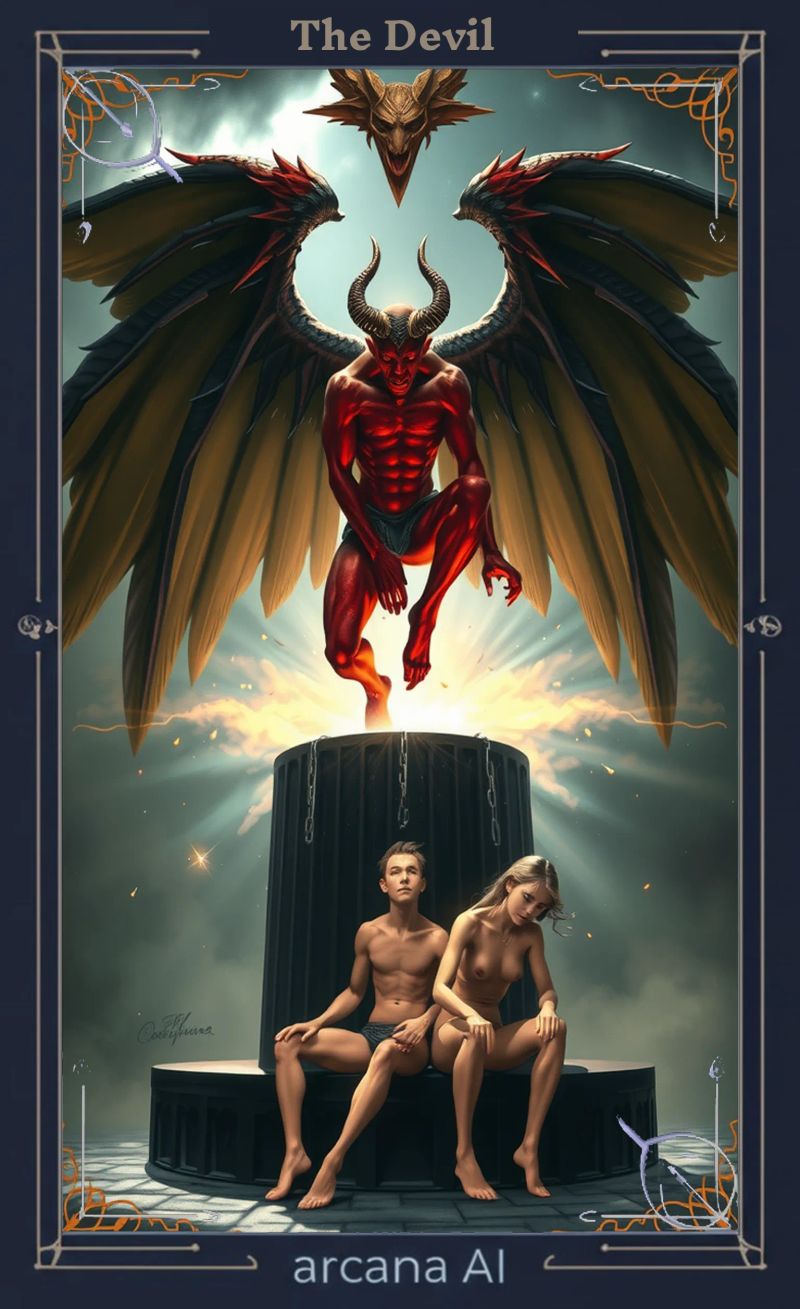The Devil (XV)
Major Arcana - Card XV
The Devil represents the primal forces of bondage, materialism, and self-imposed limitations. This card embodies the shadow aspects of human nature, the chains of addiction and toxic patterns, and the illusions that keep us trapped in cycles of suffering and limitation.
Upright Meaning
When The Devil appears upright in a reading, it signifies bondage, addiction, or self-imposed limitations. You may be feeling trapped by material concerns, toxic relationships, or addictive patterns. This card calls for honest examination of what holds you captive and the courage to break free.
Key Themes:
- Bondage and self-imposed limitations
- Materialism and addiction
- Shadow aspects and primal instincts
- Toxic relationships and codependency
- The illusion of entrapment
Practical Applications: In relationships, The Devil may indicate toxic dynamics, codependency, or relationships based on fear rather than love. In career matters, it suggests being trapped in unfulfilling work due to financial concerns or lack of confidence. For personal growth, this card encourages shadow work and confronting the aspects of yourself you’ve been avoiding.
Reversed Meaning
When reversed, The Devil can indicate liberation from bondage, breaking free from toxic patterns, or the release from addictive behaviors. You may be gaining awareness of self-imposed limitations and finding the courage to break free.
Key Themes:
- Liberation from bondage and addiction
- Breaking free from toxic patterns
- Release from material limitations
- Shadow integration and self-awareness
- Reclaiming personal power
Shadow Work: The reversed Devil suggests that you’re ready to confront and integrate your shadow aspects, break free from limiting beliefs, and release toxic attachments that have been holding you back.
Symbolism and Imagery
The Rider-Waite-Smith depiction of The Devil shows a horned, winged figure perched on a pedestal, holding a flaming torch. Two naked figures with chains around their necks stand below, appearing both tormented and strangely accepting of their bondage. The background is dark and foreboding.
The Devil Figure: The horned, winged Devil represents primal instincts, the shadow self, and the material aspects of existence. The figure’s throne-like pedestal suggests that these primal forces have been given power through our own choices and attachments.
The Chained Figures: The man and woman with chains around their necks represent humanity’s bondage to material concerns, addictions, and base instincts. The loose chains suggest that the bondage is self-imposed and can be released through conscious choice.
The Inverted Pentagram: The five-pointed star pointing downward symbolizes the material world dominating the spiritual, the triumph of base instincts over higher consciousness, and the inversion of divine will.
The Colors:
- Black background: The unknown, the shadow, and the unconscious
- Red Devil figure: Passion, anger, and primal life force
- Flesh tones of captives: Human vulnerability and exposure
- Gray pedestal: Cold materialism and rigid structures
Symbolic Elements:
- Loose chains: Self-imposed bondage and the illusion of entrapment
- Horns and wings: Animal instincts combined with the potential for transcendence
- Flaming torch: The consuming nature of unchecked desires
Historical Context
The Devil card has evolved significantly from early tarot depictions, which often showed demonic figures associated with the Christian concept of evil. In the Rider-Waite-Smith tradition, the card takes on deeper psychological and spiritual meaning, representing the shadow aspects of human nature and the illusions that bind us.
The card draws from various esoteric traditions, including the concept of the “devil” as the material world that distracts us from spiritual growth, and the alchemical principle of “nigredo” - the dark night of the soul that precedes transformation.
Card Combinations and Interactions
With The Lovers: Suggests that relationship choices may be influenced by base instincts or fear rather than true love and spiritual connection.
With The Tower: Amplifies themes of necessary destruction and liberation from false structures and illusions.
With Temperance: Indicates that finding balance and moderation can help overcome addictive patterns and material bondage.
With Death: Suggests that profound transformation requires confronting and releasing shadow aspects and toxic attachments.
With The Moon: Creates a combination emphasizing illusion, deception, and the need to confront hidden fears and motivations.
Astrological and Elemental Correspondences
Astrological Sign: Capricorn - The sign of materialism, structure, and worldly ambition. Capricorn’s association with The Devil emphasizes the shadow aspects of achievement, the temptation of material success, and the rigidity that can trap us in limiting structures.
Element: Earth - Representing materialism, the body, and physical concerns. The earth element in The Devil is heavy and dense, like the weight of material attachments that keep us grounded but also bound.
Planet: Saturn - The planet of limitation, structure, and karmic lessons. Saturn’s influence suggests that Devil energy often manifests as necessary challenges that force us to confront our limitations and grow through adversity.
Hebrew Letter: Ayin (ע) - Meaning “eye,” representing perception, awareness, and the ability to see through illusions. The letter Ayin reminds us that liberation from Devil energy comes through conscious awareness and clear perception.
Explore More
Discover deeper insights about this card by using the Arcana AI app for personalized tarot readings tailored to your specific situation and question.
